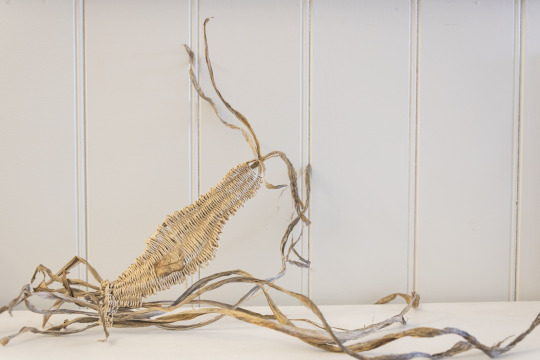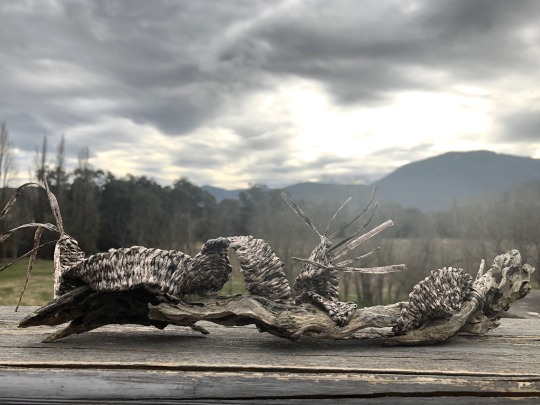Photo

Neptune’s necklace - Cyanotype on Berger Cot. 320
“How fitting that the first images affixed to a published page were of organisms that collect light for a living” (Espelie, E 2011). Anna Atkins is not only credited with being the first woman photographer, but was the first person to publish a photography book. Atkins’ cyanotypes of botanical studies are revered as works of art throughout the world. Today, cyanotypes endure as an expressive medium, largely unchanged from the original chemistry. Although I have a multi-faceted art practice, cyanotypes are one of my favourite and lasting passions. The process of making them never fails to ground me and re-establish my love for this simple process. They create a starting block from which I can continuously re-start my adventures in art. So, when the sun was shining on my first morning at Gunyah, I walked down to the water’s edge and gathered what the sea had left behind. The weather was threatening rain, so I had to work fast and create a small series of Cyanotype prints, recording the environment around me. The process teaches patience as you can’t actually “work fast”, you are relying on the sun to expose the images, so you have to judge the clouds and time the amount of sunshine you are going to get. The resulting prints always manage to life my spirits and switch my mind away from domestic problems and into my art bubble. Freedom! Ten whole days to focus solely on art making! What a privilege.
0 notes
Photo

Jackie Abrams - She Bore Witness - wire, cheesecloth, thread and fabric
0 notes
Photo

From the garden - from the detritus of last year’s withered Iris leaves
from the garden it emerges
0 notes
Photo

Eva Hesse - Right After (1969)
“Don’t ask what it means or what it refers to. Don’t ask what the work is. Rather, see what the work does.” Eva Hesse
This work evokes the very idea of Connections - it hangs like a web over it’s own shadows. As in the natural world it evokes geometric and organic shapes, repetition and uniqueness, disorder and order. Hesse always tried to keep her work away from the term “beautiful”, however this piece seems to have escaped that restraint and has strayed into the aesthetically beautiful area. I gaze at it in wonder. Which raises the question surrounding wonder..... what is wonder and does it have a place in the appreciation of art? For myself, wonder is an emotion that arises in response to extraordinary things. It’s an emotion influenced by culture and nature... marvel, bewilderment and awe - together these become wonder. Wonder can sit alongside the sublime...... it doesn’t have to be in response solely to beauty, but can be triggered by imagination and intellect in response to the transfiguration of something from the commonplace to the extraordinary.
Rene Descartes says “ Wonder can be useful in making us learn and retain in our memory things we have previously been ignorant of, for we wonder only at what appears rare and extraordinary to us”
0 notes
Photo

Rachel Berwick - Zugunruhe 2009
In 1870 there were billions of Passenger Pigeons, by 1890 only a few dozen existed and by 1900 they were extinct in the wild. One Pigeon - Martha, who lived at the Cincinnati Zoo lived for another 14 years and then there were none. Their extinction was probably the first in history that taught us about the fragility of the natural environment, the first where we could see the result of human interference. Unfortunately, the Passenger Pigeon, was also a bird from whom we could have learned much about the migratory patterns of birds and the How and the Why. Zugunruhe is an ornithological term used to describe the phenomenon of nighttime restlessness and agitation displayed by birds at the onset of migration - in Berwick’s installation - zugunruhe is arrested - there is only quiet and stillness, just the memory remains. This work is like a monument to nature as entertainment or a constructed experience, a new kind of theatre or a phenomenological experience. It creates a sense of Wonder and through Wonder will we learn to remember what has been before? And from remembering, can we learn to change? “And it can be said in particular of Wonder that it is useful in making us learn and retain in our memory things we have previously been ignorant of, for we wonder only at what appears rare and extraordinary to us” Rene Descartes.
0 notes
Photo


John Wolseley - Top Image - excerpt from “Natural History of a Sphagnum Bog” Bottom Image - flight of paper ventifacts
The bottom image is a juxtaposition of the flight of paper left in a forest against the Keeling Curve. The Keeling curve is one of the most important scientific diagrams of our time. It measures the rise of CO2 in our atmosphere since 1958. I am always intrigued and fascinated by the interaction of art and science, there is, in my opinion, a complete overlap of disciplines when it comes to talking about Nature. Both of these images were part of the Exhibition - Heartlands and Headwaters at NGV 2015. Each image in the exhibition is accompanied by detailed writings and interestingly, each one is given a Musical key notation... eg. Key of C minor. Sense of fragility and the ephemeral. Lacrimae rerum – the tears of things. - Key of F-sharp minor. Confliction.. This speaks to me of deep connections, connections involving more than one of our senses - when we look at art - are we just using our vision? What if we can involve our other senses? What if, we can relate our visual perception with memories of auditory perception? We don’t actually have to hear it in the present, but the words can trigger memories to make connections with things we have heard. Even the name of F sharp minor - doesn’t sound as sweet as G major!
0 notes
Quote
We shall not cease from exploration
and the end of all our exploring
Will be to arrive where we started
And know the place for the first time
T. S. Eliot
In his book “The Wild Places”, Robert MacFarlane goes on some journeys to try and discover the wild places that are left in Britain, however, he finally realises that the wild is all around us - you just have to know what you are looking for. His journeys revealed to him new ways of seeing the connections beyond those physically obvious ones like motorways and flight paths. There are geological ones, migration lines of birds and animals, unpredictable movements of weather and light and people - both dead and alive who lived in or passed through the landscape. All these things create a web of stories and memories which join all the places, he could see new patterns over the country, more than the mesh of roads and cities. A road atlas will get you from A to B, but it doesn’t account for the many aspects of the country - it doesn’t talk about the movement of mud in the estuaries, or the smells and sounds in the woods, the way the pollens float in the wind, the mists over the hills or even the struggle of the dandelion as it pushes it’s way through the concrete footpaths of the city. The wild can return us to ourselves.
0 notes
Audio
This is such a simple song, yet fills my head with images of summer fun! It speaks in simple language of the connection of the singer to the season, to the water, to the simple joy of living. It’s not complicated, it’s plain and simple, but effective in bringing images to the mind of the listener. It’s a song full of fun of living life fully and joyfully and being at one with the natural world, I can hear laughter and splashing and am reminded to treasure moments and not let Joy be so short lived! There is no pressure to find deeper meanings to the lyrics, they simply say what they want to say.
0 notes







